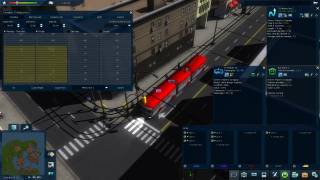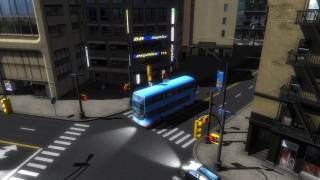Overview
Cities in Motion 2 is a transport management simulation game developed by Colossal Order and published by Paradox Interactive. It is the sequel to 2011's Cities in Motion and was released for the PC and Mac on April 2, 2013. Cities in Motion 2 discards the historical aspect of the first game, instead focusing on the modern day, and features fictional cities instead of real ones. The game contains both cooperative and competitive multiplayer modes, where players take control of different companies competing in the same city.
Gameplay
Day/Night Cycle
 A Timetable
A TimetableCities in Motion 2 introduces a day/night cycle, with a full 7-day week and peak periods in the morning and evening. Players now have to take into consideration the movements of the residents throughout the week, and provide transportation to both their workplaces and their leisure places. To this end, players are given the ability to adjust the timetables for their routes, setting departure times from the route's first stop.
City Growth and Roads
Cities do not grow in set patterns like the first game. Instead, players can dictate the growth of the city, by laying down roads and providing adequate transportation capacity to the area. The city will also develop naturally along existing roads, changing constantly throughout the game. However, players cannot lay down individual buildings themselves in a normal game, outside of Landmarks (which come as a DLC).
Players can also lay down their own roads, and there are much more options for road networks, including pedestrian walkways and expressways. Most road options also come with the ability to set bus lanes, which limit traffic to the player's vehicles. All roads can be raised or lowered to create bridges and tunnels when needed.
Vehicles and Depots
Like the first game, there are 5 modes of transport, each with their own characteristics. They are:
- Buses: The cheapest option, but has low capacities and is affected by traffic.
- Trolleybuses: Powered by overhead caternary wires, they have slightly higher capacities and speeds compared to buses, but are still restricted to roads.
- Trams: The middle of the road option, providing a balance of capacity and cost. Tram tracks are restricted to existing roads, but can be laid in the median of an avenue and pedestrian walkways. Trams can also travel on metro rail, but stops cannot be placed there.
- Metro: The most expensive option, metro provide high speed and capacity, and rails can be built both above and below ground, separate from other networks.
- Water Buses: Ferries that cross rivers and waterways, providing a cheap alternative to a bridge or tunnel.
 A Double Decker Bus
A Double Decker BusUnlike Cities in Motion, all vehicles are now stationed in depots built by the player. each route is linked to a depot, and vehicles are drawn from the depot when needed. Vehicles are maintained in their depots, and if a vehicle goes for a long time without returning to a depot, it's maintenance value will drop and it will break down. Vehicles can be moved from 1 depot to another at will, and a depot can be linked to multiple routes.
System Requirements
| PC | Mac |
|---|
Minimum - OS:Microsoft Windows XP/Vista/7/8
- Processor:2 GHz Dual core
- Memory:3 GB RAM
- Graphics:nVIDIA GeForce 8800, 512 MB RAM or ATI Radeon HD 3850, 512 MB RAM
- DirectX®:9.0
- Hard Drive:2 GB HD space
- Other Requirements:Broadband Internet connection
Recommended - OS:: Microsoft Windows 7/8
- Processor:3 GHz Quad core
- Memory:4 GB RAM
- Graphics:nVIDIA GeForce GTX460, 1 GB RAM or AMD Radeon HD 6850, 1 GB RAM
- DirectX®:9.0
- Hard Drive:2 GB HD space
- Other Requirements:Broadband Internet connection
| Minimum - OS:OSX Snow Leopard 10.6.3
- Processor:2 GHz Dual core
- Memory:3 GB RAM
- Graphics:nVIDIA GeForce 8800, 512 MB RAM or ATI Radeon HD 3850, 512 MB RAM
- Hard Drive:2 GB HD space
- Other Requirements:Broadband Internet connection
Recommended - OS:OSX Snow Leopard 10.6.3 or later
- Processor:3 GHz Quad core
- Memory:4 GB RAM
- Graphics: nVIDIA GeForce GTX460, 1 GB RAM or AMD Radeon HD 6850, 1 GB RAM
- Hard Drive:2 GB HD space
- Other Requirements:Broadband Internet connection
|
Log in to comment